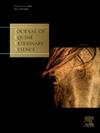实时经直肠超声测量胎儿眼(玻璃体)预测逆行母马的分娩。
IF 1.3
3区 农林科学
Q2 VETERINARY SCIENCES
引用次数: 0
摘要
监测妊娠期和预测未知的母马分娩日期是具有挑战性的,特别是在牧场饲养的一群野马。经直肠超声测量胎儿玻璃体体长是一种有效的预测产驹日期的方法,但先前的研究表明,需要特定品种的参数来为各自品种制定准确的指标。本研究的目的是建立一种将胎儿玻璃体长度与分娩前天数(DBP)联系起来的量表。两年两次的数据收集在240次生殖检查中确定了199例妊娠,其中155例胎儿眼睛被成功识别和测量(78%)。131例成功的胎儿眼部检查(n=131)确认的产蛋日期可以计算DBP。单经直肠超声测量胎儿眼的长度,测量到玻璃体在晶状体水平的最大尺寸,范围从9到35毫米。多水平混合效应线性回归方法得到曲线方程DBP= -0.163(胎儿眼长测量单位:mm) 2 + 268.949 (r=0.881, p本文章由计算机程序翻译,如有差异,请以英文原文为准。
Real-time transrectal ultrasonographic measurement of the fetal eye (vitreous body) to predict parturition in bucking horse mares
Monitoring gestation and predicting parturition in mares with unknown breeding dates is challenging, especially in pasture bred herds of bucking horses. Transrectal ultrasonographic measurement of fetal vitreous body length is a validated predictor of foaling dates, but previous research suggested a need for breed-specific parameters to develop accurate indices for respective breeds. This study aimed to develop a scale associating fetal vitreous body length with days before parturition (DBP) in bucking horses. Biannual data collection over 2 years identified 199 pregnancies out of 240 reproductive examinations, of which 155 fetal eyes were successfully identified and measured (78 %). Foaling dates confirmed for 131 successful fetal eye examinations (n = 131) enabled DBP calculation. A single transrectal ultrasonographic measurement was collected of the length of the fetal eye measured to the maximum dimensions of the vitreous body at the level of the lens, ranging from 9 to 35 mm. Multilevel mixed-effects linear regression methodology yielded the curvilinear equation DBP= -0.163(fetal eye length measurement in mm) 2 + 268.949 (r = 0.881, p < 0.001, concordance=0.994, average difference -0.077±17.214 days), which accurately calculates DBP in bucking horses based on transrectal ultrasonographic measurement of the fetal eye. Although this newly developed equation is similar to a previously reported equation for use in small ponies, applying the equation used for DBP prediction in small ponies to bucking horse pregnancies resulted in a small, but significant underestimation in predicting bucking horse DBP.
求助全文
通过发布文献求助,成功后即可免费获取论文全文。
去求助
来源期刊

Journal of Equine Veterinary Science
农林科学-兽医学
CiteScore
2.70
自引率
7.70%
发文量
249
审稿时长
77 days
期刊介绍:
Journal of Equine Veterinary Science (JEVS) is an international publication designed for the practicing equine veterinarian, equine researcher, and other equine health care specialist. Published monthly, each issue of JEVS includes original research, reviews, case reports, short communications, and clinical techniques from leaders in the equine veterinary field, covering such topics as laminitis, reproduction, infectious disease, parasitology, behavior, podology, internal medicine, surgery and nutrition.
 求助内容:
求助内容: 应助结果提醒方式:
应助结果提醒方式:


